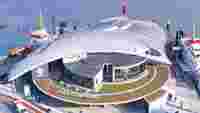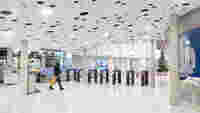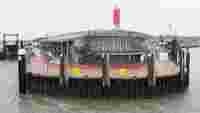Welcome to Norderney!

The new harbor terminal for the Frisia Shipping Company on Norderney, Germany, boasts more than impressive architecture – it also showcases complex building technology. Components from WAGO ensure that it works together perfectly.
A certain level of understatement is usually attributed to northern Germans. The new harbor terminal for the Norden-Frisia Shipping Company on Norderney upends this cliché. Terms like “futuristic,” “ultra-modern,” and “stellar,” which have been used to describe the building, are rather atypical of northern Germany. Yet they suit the building. For around ten million euros, Frisia has built a new, state-of-the-art harbor terminal, whose rounded shapes embed it in the island landscape and have earned it the apt name of “Hafendüne”, or Harbor Dune. “Square, practical and cheap was not appealing to us,” explains Weddermann, Project Manager, as well as Assistant Manager of the shipping company.

